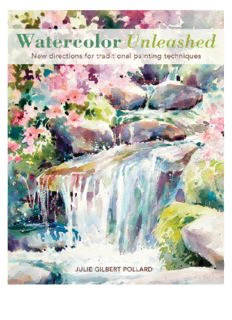
Watercolor Unleashed: New Directions for Traditional Painting Techniques PDF
Preview Watercolor Unleashed: New Directions for Traditional Painting Techniques
Watercolor Unleashed New directions for traditional painting techniques JULIE GILBERT POLLARD Contents Introduction Basic Watercolor Materials Additional Watercolor Materials Acrylic Materials Plein Air Materials Watercolor Essentials Drawing and Composition Basics Value Basic Color Theory Design Negative and Positive Shapes Paint Consistency Paint Using a Manageable Process Drawing and Composing Your Painting Blind Contour Sketch Executing a Blind Contour Sketch Gesture Sketches Thumbnail Studies Value Sketches Avoiding Tangents Asymmetry Asymmetrical Composition Assessing the Final Painting Abstract to Realism Improved Design With Abstract Studies Abstract Study to Finished Painting Brilliant Color, Simplified The Triadic Color Wheel Color Temperature Understanding Neutral Colors Mixing Neutrals Use Color as Value Painting With Primary Colors Nine Lessons for Negative Painting Why Negative Painting? Three Concepts for Creating Shapes Modeling Negative Shapes Painting From Light to Dark Continuous Variegated Wash Wet-Into-Wet and Wet-On-Dry Overlapping Washes Intuitive Negative Painting Spattering Using Layers to Create Depth Spice Up Watercolors With Acrylics Enjoy the Process Underpaint in Acrylic Locking in Darks With Acrylics Delight in the Landscape Painting En Plein Air Painting Vegetation Simplifying Complex Shapes Rocks Capturing the Landscape’s Essence Anatomy of a Creek Painting a Creek Cascading Water Dedication Acknowledgments About the Author Introduction ITTLIE BITTIE FISHIES Watercolor on board 19” × 19” (48cm × 48cm) EARLY FALL, TRINITY RIVER Watercolor on canvas 12” × 12” (30cm × 30cm) Watercolor—especially an expanded watermedia version of watercolor—is an exciting and expressive medium. You can do almost anything with it, particularly when using the many water-based products, papers and canvases that are available to us. Watercolor has been maligned as an extremely unforgiving medium. While this is true to some extent, even purely transparent watercolor is more easily manipulated than you might imagine. As you go through the step-by-step demos, you will see where paint has been gently lifted or not so gently scrubbed, then repainted in such a way as to revive freshness. Then, in a worst case scenario, painted over with gouache, casein or acrylic. Regarding opaque media, lest you think the addition of an opaque medium such as gouache is merely a last resort fix, it must be said that opaque mediums can add beautiful qualities and dimensions to a painting that you might not be able to achieve otherwise. It must also be acknowledged that opaque media are highly respected in their own right, so why not incorporate any and all media to improve and complete a painting? Still, watercolor can be a mysterious and challenging medium—and even with experience, truth be told, the challenge remains. As artists, we simply keep raising the bar and expecting more of ourselves—as happens with every worthwhile endeavor. And if we weren’t the kind of folk who need to be challenged, we wouldn’t be painting! Most of my work in watercolor is “transparent.” But I am not a purist—my philosophy is of the “whatever works” school. Not bound by tradition but truly watercolor unleashed! So, come with me and let’s see if we can demystify the process—and delight in the practice of this beautiful and versatile medium. Basic Watercolor Materials Whatever you do, do not buy all the colors or other supplies you see here just because they’re on my list. I often use no more than six colors in any given painting and can get by with three. I have labeled the colors as warm, warmer, cool, cooler and very cool. I use no earth tones and few secondary colors. YELLOW PIGMENTS • Winsor Yellow (Winsor & Newton) • Nickel Azo Yellow (Winsor & Newton) • New Gamboge (Winsor & Newton)—warm • Indian Yellow (M. Graham or Winsor & Newton)—warmer RED PIGMENTS • Scarlet Lake (Holbein) or Quinacridone Red (M. Graham)—warm • Permanent Alizarin Crimson (Winsor & Newton)—cool • Permanent Rose (Winsor & Newton) or Quinacridone Rose (M. Graham)—cool • Quinacridone Magenta (Winsor & Newton)—cooler BLUE PIGMENTS • Ultramarine Deep (Holbein)—warmer • Cobalt Blue (Winsor & Newton or M. Graham [for plein air palette])—warm • Indanthrene Blue (Winsor & Newton) or Anthraquinone Blue (M. Graham)—warm • Antwerp Blue (Winsor & Newton)—cool • Cerulean Blue (Winsor & Newton)—cool • Manganese Blue Nova (Holbein or M. Graham Manganese Blue Hue [for plein air palette])—cooler • Transparent Turquoise (Daler-Rowney)—cooler • Turquoise Blue (Holbein) —cooler • Ultramarine Turquoise (Daniel Smith)—very cool OPAQUE COLORS • Titanium White Casein (Shiva) or Titanium White Gouache (no particular brand) • Jaune Brillant # 1 (Holbein) • Jaune Brillant # 2 (Holbein) • Primary Yellow (Winsor & Newton Designers Gouache) BRUSHES • Nos. 8 and 14 nylon, synthetic or natural blend rounds (Connoisseur Kolinsky sable or Winsor & Newton Sceptre Gold 101) • 1⁄2-inch (12mm), 3⁄4-inch (19mm) and 1-inch (25mm) nylon or synthetic blend Aquarelle (no particular brand) • 2-inch (5mm) hake (no particular brand) or wash brush • No. 4 scrubber (Creative Mark) SUPPORT • 100% rag, 140-lb. (300gsm) or 300-lb. (640gsm) cold-pressed watercolor paper (Lanaquarelle, Winsor & Newton, Canson Montval or Arches) • Multimedia canvas (Yes!) or watercolor canvas (Fredrix). Use sheets stapled to Gatorboard. Canvas prestretched onto stretcher bars or premounted onto boards are also available. A Word About Watercolor on Canvas
Description: